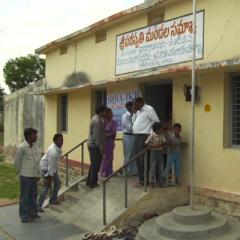Your progress
0%
Here are some of the key ideas you need to understand in order to support rehabilitation in the communities your organization serves.
Use your mouse or keyboard to expand each of the headings below.
Rehabilitation is relevant to people experiencing disability from a broad range of health conditions. Habilitation aims to assist those individuals who were born with impairments, or acquired them in in early childhood, and who require services to optimize their functioning. Rehabilitation aims to assist those who experience a loss in functioning as a result of disease or injury, and who need to relearn or reacquire this functioning or develop alternative ways of functioning to serve the same purpose.
A wide range of rehabilitation interventions can be undertaken within the health sector. Consider the examples below.
See how a rehabilitation exercise programme has improved the functioning of a young girl in India.

Rehabilitation services are managed by government, private or nongovernmental sectors.
In most countries, the ministry of health manages these services. In some countries, these services are managed by other ministries, such as the ministry of labour or social welfare. In still other countries, services may be managed through joint partnerships between government ministries and nongovernmental organizations.
Services are provided by a broad range of personnel: medical professionals, such as nurses and physiatrists; therapy professionals, such as occupational therapists, physiotherapists and speech therapists; technology specialists, such as orthotists and prosthetists; and rehabilitation workers, such as rehabilitation assistants and community rehabilitation workers.
Rehabilitation services can be offered in a wide range of settings, including hospitals, clinics, specialist centres or units and community facilities and homes.
In many places, and particularly in rural areas, the range of rehabilitation services is often limited. Because of this, community-based strategies such as CBR are essential for linking and providing people with disabilities and their families with rehabilitation services.
See how a community-based rehabilitation centre in India is improving the lives of children with disabilities through intensive physiotherapy.

Rehabilitation at specialized centres may not be necessary or practical for many people, particularly those living in rural areas. If so, then rehabilitation activities can be initiated in the community. The WHO manual on Training in the community for people with disabilities is a guide to rehabilitation activities that can be carried out in the community using local resources.
Community-based services may also be required following rehabilitation at specialized centres. A person may require continued support and assistance in using new skills and knowledge at home and in the community after returning from rehabilitation. CBR can provide support by visiting people at home and encouraging them to continue rehabilitation activities as necessary.
Where rehabilitation services are established in the community, close links must be maintained with referral centres that offer specialized rehabilitation services. The needs of many people with disabilities change over time and they may require periodic support in the long term. Successful rehabilitation depends on strong partnerships between people with disabilities, rehabilitation professionals and community-based workers.
Rehabilitation plans need to be person-centred, goal-oriented and realistic.
When developing a plan, a person’s preferences, age, gender, socioeconomic status and home environment need to be considered. Rehabilitation is often a long journey, and a long-term vision is required, supplemented by short-term goals. Valuable resources can be wasted when rehabilitation plans are not realistic.
Many rehabilitation plans fail because people with disabilities are not consulted; it is important to ensure that their opinions and choices influence the development of the plan and that the realities of their lives, in particular the issue of poverty, are considered.
Rehabilitation needs may change over time, particularly during periods of transition, as when a child starts school, a young adult starts work, or a person returns to live in his or her community following a stay in a rehabilitation facility. During these transitions, adjustments will need to be made to the rehabilitation plans to ensure that the activities continue to be appropriate and relevant.